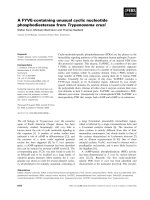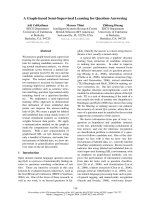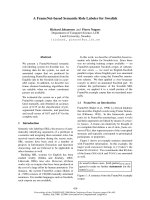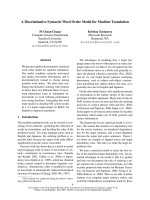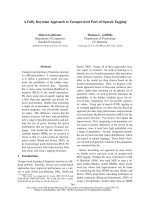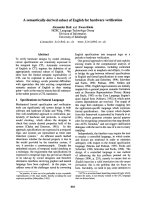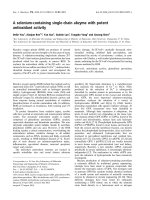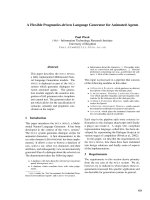Báo cáo khoa học: "A Clustered Global Phrase Reordering Model for Statistical Machine Translation" docx
Bạn đang xem bản rút gọn của tài liệu. Xem và tải ngay bản đầy đủ của tài liệu tại đây (176.32 KB, 8 trang )
Proceedings of the 21st International Conference on Computational Linguistics and 44th Annual Meeting of the ACL, pages 713–720,
Sydney, July 2006.
c
2006 Association for Computational Linguistics
A Clustered Global Phrase Reordering Model
for Statistical Machine Translation
Masaaki Nagata
NTT Communication Science Laboratories
2-4 Hikaridai, Seika-cho, Souraku-gun
Kyoto, 619-0237 Japan
,
Kuniko Saito
NTT Cyber Space Laboratories
1-1 Hikarinooka, Yokoshuka-shi
Kanagawa, 239-0847 Japan
Kazuhide Yamamoto, Kazuteru Ohashi
Nagaoka University of Technology
1603-1, Kamitomioka, Nagaoka City
Niigata, 940-2188 Japan
,
Abstract
In this paper, we present a novel global re-
ordering model that can be incorporated
into standard phrase-based statistical ma-
chine translation. Unlike previous local
reordering models that emphasize the re-
ordering of adjacent phrase pairs (Till-
mann and Zhang, 2005), our model ex-
plicitly models the reordering of long dis-
tances by directly estimating the parame-
ters from the phrase alignments of bilin-
gual training sentences. In principle, the
global phrase reordering model is condi-
tioned on the source and target phrases
that are currently being translated, and
the previously translated source and tar-
get phrases. To cope with sparseness, we
use N-best phrase alignments and bilin-
gual phrase clustering, and investigate a
variety of combinations of conditioning
factors. Through experiments, we show,
that the global reordering model signifi-
cantly improves the translation accuracy
of a standard Japanese-English translation
task.
1 Introduction
Global reordering is essential to the translation of
languages with different word orders. Ideally, a
model should allow the reordering of any distance,
because if we are to translate from Japanese to En-
glish, the verb in the Japanese sentence must be
moved from the end of the sentence to the begin-
ning just after the subject in the English sentence.
Graduated in March 2006
Standard phrase-based translation systems use
a word distance-based reordering model in which
non-monotonic phrase alignment is penalized
based on the word distance between successively
translated source phrases without considering the
orientation of the phrase alignment or the identi-
ties of the source and target phrases (Koehn et al.,
2003; Och and Ney, 2004). (Tillmann and Zhang,
2005) introduced the notion of a block (a pair of
source and target phrases that are translations of
each other), and proposed the block orientation
bigram in which the local reordering of adjacent
blocks are expressed as a three-valued orienta-
tion, namely Right (monotone), Left (swapped),
or Neutral. A block with neutral orientation is sup-
posed to be less strongly linked to its predecessor
block: thus in their model, the global reordering is
not explicitly modeled.
In this paper, we present a global reordering
model that explicitly models long distance re-
ordering
1
. It predicts four type of reordering
patterns, namely MA (monotone adjacent), MG
(monotone gap), RA (reverse adjacent), and RG
(reverse gap). There are based on the identities of
the source and target phrases currently being trans-
lated, and the previously translated source and tar-
get phrases. The parameters of the reordering
model are estimated from the phrase alignments of
training bilingual sentences. To cope with sparse-
ness, we use N-best phrase alignments and bilin-
gual phrase clustering.
In the following sections, we first describe the
global phrase reordering model and its param-
1
It might be misleading to call our reordering model
“global” since it is at most considers two phrases. A truly
global reordering model would take the entire sentence struc-
ture into account.
713
eter estimation method including N-best phrase
alignments and bilingual phrase clustering. Next,
through an experiment, we show that the global
phrase reordering model significantly improves
the translation accuracy of the IWSLT-2005
Japanese-English translation task (Eck and Hori,
2005).
2 Baseline Translation Model
In statistical machine translation, the translation of
a source (foreign) sentence
is formulated as the
search for a target (English) sentence that max-
imizes the conditional probability , which
can be rewritten using the Bayes rule as,
where is a translation model and is a
target language model.
In phrase-based statistical machine translation,
the source sentence
is segmented into a sequence
of phrases , and each source phrase is trans-
lated into a target phrase
. Target phrases may be
reordered. The translation model used in (Koehn
et al., 2003) is the product of translation probabil-
ity and distortion probability ,
(1)
where denotes the start position of the source
phrase translated into the -th target phrase, and
denotes the end position of the source phrase
translated into the -th target phrase.
The translation probability is calculated from
the relative frequency as,
(2)
where is the frequency of alignments
between the source phrase and the target phrase
.
(Koehn et al., 2003) used the following dis-
tortion model, which simply penalizes non-
monotonic phrase alignments based on the word
distance of successively translated source phrases
with an appropriate value for the parameter ,
(3)
܂ݶ ᬢ ᬡ ౕ ᬚ ᬾ
language
is
a
means
commu-
nication
of
MG
RA
RA
b
1
b
2
b
3
b
4
܂ݶ ᬢ ᬡ ౕ ᬚ ᬾ
language
is
a
means
commu-
nication
of
MG
RA
RA
b
1
b
2
b
3
b
4
Figure 1: Phrase alignment and reordering
b
i-1
b
i
f
i-1
f
i
e
i-1
e
i
b
i-1
b
i
f
i-1
f
i
e
i-1
e
i
b
i-1
b
i
f
i-1
f
i
e
i-1
e
i
b
i-1
b
i
f
i-1
f
i
e
i-1
e
i
source
target target
source
target target
source source
d=MA d=MG
d=RA d=RG
Figure 2: Four types of reordering patterns
3 The Global Phrase Reordering Model
Figure 1 shows an example of Japanese-English
phrase alignment that consists of four phrase pairs.
Note that the Japanese verb phrase “ ” at
the the end of the sentence is aligned to the English
verb “is” at the beginning of the sentence just after
the subject. Such reordering is typical in Japanese-
English translations.
Motivated bythe three-valued orientation for lo-
cal reordering in (Tillmann and Zhang, 2005), we
define the following four types of reordering pat-
terns, as shown in Figure 2,
monotone adjacent (MA): The two source
phrases are adjacent, and are in the same or-
der as the two target phrases.
monotone gap (MG): The two source phrases
are not adjacent, but are in the same order as
the two target phrases.
reverse adjacent (RA): The two source
phrases are adjacent, but are in the reverse or-
der of the two target phrases.
714
J-to-E C-to-E
Monotone Adjacent 0.441 0.828
Monotone Gap 0.281 0.106
Reverse Adjacent 0.206 0.033
Reverse Gap 0.072 0.033
Table 1: Percentage of reordering patterns
reverse gap (RG): The two source phrases are
not adjacent, and are in the reverse order as
the two target phrases.
For the global reordering model, we only con-
sider the cases in which the two target phrases
are adjacent because, in decoding, the target sen-
tence is generated from left to right and phrase by
phrase. If we are to generate the
-th target phrase
from the source phrase , we call and the
current block
, and and the previous
block .
Table 1 shows the percentage of each reorder-
ing pattern that appeared in the N-best phrase
alignments of the training bilingual sentences for
the IWSLT 2005 Japanese-English and Chinese-
English translation tasks (Eck and Hori, 2005).
Since non-local reorderings such as monotone gap
and reverse gap are more frequent in Japanese to
English translations, they are worth modeling ex-
plicitly in this reordering model.
Since the probability of reordering pattern
(in-
tended to stand for ‘distortion’) is conditioned on
the current and previous blocks, the global phrase
reordering model is formalized as follows:
(4)
We can replace the conventional word distance-
based distortion probability in Equa-
tion (1) with the global phrase reordering model
in Equation (4) with minimal modification of the
underlying phrase-based decoding algorithm.
4 Parameter Estimation Method
In principle, the parameters of the global phrase
reordering model in Equation (4) can be estimated
from the relative frequencies of respective events
in the Viterbi phrase alignment of the training
bilingual sentences. This straightforward estima-
tion method, however, often suffers from sparse
data problem. To cope with this sparseness, we
used N-best phrase alignment and bilingual phrase
ᬡ ౕ
᭞ᮊᮐ᭶
᭜ ᮧ ᭢ ᮒ ᮞ
means
commu-
nication
of
1 2 3
4 5
6 7 8
Figure 3: Expansion of a phrase pair
clustering. We also investigated various approx-
imations of Equation (4) by reducing the condi-
tional factors.
4.1 N-best Phrase Alignment
In order to obtain the Viterbi phrase alignment
of a bilingual sentence pair, we search for the
phrase segmentation and phrase alignment that
maximizes the product of the phrase translation
probabilities
,
(5)
Phrase translation probabilities are approximated
using word translation probabilities and
as follows,
(6)
where and are words in the target and source
phrases.
The phrase alignment based on Equation (5) can
be thought of as an extension of word alignment
based on the IBM Model 1 to phrase alignment.
Note that bilingual phrase segmentation (phrase
extraction) is also done using the same criteria.
The approximation in Equation (6) is motivated
by (Vogel et al., 2003). Here, we added the second
term to cope with the asymmetry between
and . The word translation proba-
bilities are estimated using the GIZA++ (Och and
Ney, 2003).
The above search is implemented in the follow-
ing way:
1. All source word and target word pairs are
considered to be initial phrase pairs.
715
2. If the phrase translation probability of the
phrase pair is less than the threshold, it is
deleted.
3. Each phrase pair is expanded toward the eight
neighboring directions as shown in Figure 3.
4. If the phrase translation probability of the ex-
panded phrase pair is less than the threshold,
it is deleted.
5. The process of expansion and deletion is re-
peated until no further expansion is possible.
6. The consistent N-best phrase alignment are
searched from all combinations of the above
phrase pairs.
The search for consistent Viterbi phrase align-
ments can be implemented as a phrase-based de-
coder using a beam search whose outputs are con-
strained only to the target sentence. The consistent
N-best phrase alignment can be obtained by using
A* search as described in (Ueffing et al., 2002).
We did not use any reordering constraints, such as
IBM constraint and ITG constraint in the search
for the N-best phrase alignment (Zens et al., 2004).
The thresholds used in the search are the fol-
lowing: the minimum phrase translation probabil-
ity is 0.0001. The maximum number of translation
candidates for each phrase is 20. The beam width
is 1e-10, the stack size (for each target candidate
word length) is 1000. We found that, compared
with the decoding of sentence translation, we have
to search significantly larger space for the N-best
phrase alignment.
Figure 3 shows an example of phrase pair
expansion toward eight neighbors. If the cur-
rent phrase pair is (
, of), the expanded phrase
pairs are ( , means of), ( ,
means of), ( , means of), (
, of), ( , of), (
, of communication), ( , of communication),
and ( , of communication).
Figure 4 shows an example of the best three
phrase alignments for a Japanese-English bilin-
gual sentence. For the estimation of the global
phrase reordering model, preliminary tests have
shown that the appropriate N-best number is 20.
In counting the events for the relative frequency
estimation, we treat all N-best phrase alignments
equally.
For comparison, we also implemented a dif-
ferent N-best phrase alignment method, where
ାภ_ᬢ_ࣂ_ᬚᬊ_ᬒ
the_light_was_red
ାภ_ᬢ ࣂ_ᬚᬊ_ᬒ
the_light was_red
ାภ_ᬢ ᬚᬊ_ᬒ
the_light was
ࣂ
red
(1)
(2)
(3)
Figure 4: N-best phrase alignments
phrase pairs are extracted using the standard
phrase extraction method described in (Koehn et
al., 2003). We call this conventional phrase ex-
traction method “grow-diag-final”, and the pro-
posed phrase extraction method “ppicker” (this is
intended to stand for phrase picker).
4.2 Bilingual Phrase Clustering
The second approach to cope with the sparseness
in Equation (4) is to group the phrases into equiv-
alence classes. We used a bilingual word cluster-
ing tool, mkcls (Och et al., 1999) for this purpose.
It forms partitions of the vocabulary of the two
languages to maximize the joint probability of the
training bilingual corpus.
In order to perform bilingual phrase clustering,
all words in a phrase are concatenated by an under-
score ’
’ to form a pseudo word. We then use the
modified bilingual sentences as the input to mk-
cls. We treat all N-best phrase alignments equally.
Thus, the phrase alignments in Figure 4 are con-
verted to the following three bilingual sentence
pairs.
_ _ _ _
the_light_was_red
_ _ _
the_light was_red
_ _
the_light was red
Preliminary tests have shown that the appropriate
number of classes for the estimation of the global
phrase reordering model is 20.
As a comparison, we also tried two phrase clas-
sification methods based on the part of speech of
the head word (Ohashi et al., 2005). We defined
(arguably) the first word of each English phrase
and the last word of each Japanese phrase as the
716
shorthand reordering model
baseline
e[0]
f[0]
e[0]f[0]
e[-1]f[0]
e[0]f[-1,0]
e[-1]f[-1,0]
e[-1,0]f[0]
e[-1,0]f[-1,0]
Table 2: All reordering models tried in the experi-
ments
head word. We then used the part of speech of
the head word as the phrase class. We call this
method “1pos”. Since we are not sure whether it is
appropriate to introduce asymmetry in head word
selection, we also tried a “2pos” method, where
the parts of speech of both the first and the last
words are used for phrase classification.
4.3 Conditioning Factor of Reordering
The third approach to cope with sparseness in
Equation (4) is to approximate the equation by re-
ducing the conditioning factors.
Other than the baseline word distance-based
reordering model and the Equation (4) itself,
we tried eight different approximations of Equa-
tion (4) as shown in Table 2, where, the symbol in
the left column is the shorthand for the reordering
model in the right column.
The approximations are designed based on two
intuitions. The current block (
and ) would
probably be more important than the previous
block ( and ). The previous target phrase
( ) might be more important than the current
target phrase ( ) because the distortion model of
IBM 4 is conditioned on , and . The
appropriate form of the global phrase reordering
model is decided through experimentation.
5 Experiments
5.1 Corpus and Tools
We used the IWSLT-2005 Japanese-English trans-
lation task (Eck and Hori, 2005) for evaluating the
proposed global phrase reordering model. We re-
port results using the well-known automatic eval-
uation metrics Bleu (Papineni et al., 2002).
IWSLT (International Workshop on Spoken
Sentences Words Vocabulary
Japanese 20,000 198,453 9,277
English 20,000 183,452 6,956
Table 3: IWSLT 2005 Japanese-English training
data
Language Translation) 2005 is an evaluation cam-
paign for spoken language translation.Its task
domain encompasses basic travel conversations.
20,000 bilingual sentences are provided for train-
ing. Table 3 shows the number of words and the
size of vocabulary of the training data. The av-
erage sentence length of Japanese is 9.9 words,
while that of English is 9.2 words.
Two development sets, each containing 500
source sentences, are also provided and each
development sentence comes with 16 reference
translations. We used the second development set
(devset2) for the experiments described in this pa-
per. This 20,000 sentence corpus allows for fast
experimentation and enables us to study different
aspects of the proposed global phrase reordering
model.
Japanese word segmentation was done using
ChaSen
2
and English tokenization was done using
a tool provided by LDC
3
. For the phrase classi-
fication based on the parts of speech of the head
word, we used the first two layers of the Chasen’s
part of speech tag for Japanese. For English part
of speech tagging, we used MXPOST
4
.
Word translation probabilities are obtained by
using GIZA++ (Och and Ney, 2003). For training,
all English words are made in lower case. We used
a back-off word trigram model as the language
model. It is trained from the lowercased English
side of the training corpus using a statistical lan-
guage modeling toolkit, Palmkit
5
.
We implemented our own decoder based on the
algorithm described in (Ueffing et al., 2002). For
decoding, we used phrase translation probability,
lexical translation probability, word penalty, and
distortion (phrase reordering) probability. Mini-
mum error rate training was not used for weight
optimization.
The thresholds used in the decoding are the fol-
lowing: the minimum phrase translation probabil-
ity is 0.01. The maximum number of translation
2
/>3
/>4
/>5
/>717
ppicker grow-diag-final
class lex class lex
baseline 0.400 0.400 0.343 0.343
0.407 0.407 0.350 0.350
f[0] 0.417 0.410 0.362 0.356
e[0] 0.422 0.416 0.356 0.360
e[0]f[0] 0.422 0.404 0.355 0.353
e[0]f[-1,0] 0.407 0.381 0.346 0.327
e[-1,0]f[0] 0.410 0.392 0.348 0.341
e[-1,0]f[-1,0] 0.394 0.387 0.339 0.340
Table 4: BLEU score of reordering models with
different phrase extraction methods
candidates for each phrase is 10. The beam width
is 1e-5, the stack size (for each target candidate
word length) is 100.
5.2 Clustered and Lexicalized Model
Figure 5 shows the BLEU score of clustered and
lexical reordering model with different condition-
ing factors. Here, “class” shows the accuracy
when the identity of each phrase is represented by
its class, which is obtained by the bilingual phrase
clustering, while “lex” shows the accuracy when
the identity of each phrases is represented by its
lexical form.
The clustered reordering model “class” is gen-
erally better than the lexicalized reordering model
“lex”. The accuracy of “lex” drops rapidly as the
number of conditioning factors increases. The re-
ordering models using the part of speech of the
head word for phrase classification such as “1pos”
and “2pos” are somewhere in between.
The best score is achieved by the clustered
model when the phrase reordering pattern is con-
ditioned on either the current target phrase
or
the current block, namely phrase pair and .
They are significantly better than the baseline of
the word distance-based reordering model.
5.3 Interaction between Phrase Extraction
and Phrase Alignment
Table 4 shows the BLEU score of reordering mod-
els with different phrase extraction methods. Here,
“ppicker” shows the accuracy when phrases are
extracted by using the N-best phrase alignment
method described in Section 4.1, while “grow-
diag-final” shows the accuracy when phrases are
extracted using the standard phrase extraction al-
gorithm described in (Koehn et al., 2003).
It is obvious that, for building the global phrase
reordering model, our phrase extraction method is
significantly better than the conventional phrase
extraction method. We assume this is because the
proposed N-best phrase alignment method opti-
mizes the combination of phrase extraction (seg-
mentation) and phrase alignment in a sentence.
5.4 Global and Local Reordering Model
In order to show the advantages of explicitly mod-
eling global phrase reordering, we implemented a
different reordering model where the reordering
pattern is classified into three values: monotone
adjacent, reverse adjacent and neutral. By collaps-
ing monotone gap and reverse gap into neutral, it
can be thought of as a local reordering model sim-
ilar to the block orientation bigram (Tillmann and
Zhang, 2005).
Figure 6 shows the BLEU score of the local
and global reordering models. Here, “class3”
and “lex3”represent the three-valued local reorder-
ing model, while “class4” and “lex4”represent the
four-valued global reordering model. “Class” and
“lex” represent clustered and lexical models, re-
spectively. We used “grow-diag-final” for phrase
extraction in this experiment.
It is obvious that the four-valued global reorder-
ing model consistently outperformed the three-
valued local reordering model under various con-
ditioning factors.
6 Discussion
As shown in Figure 5, the reordering model of
Equation (4) (indicated as e[-1,0]f[-1,0] in short-
hand) suffers from a sparse data problem even if
phrase clustering is used. The empirically justifi-
able global reordering model seems to be the fol-
lowing, conditioned on the classes of source and
target phrases:
(7)
which is similar to the block orientation bigram
(Tillmann and Zhang, 2005). We should note,
however, that the block orientation bigram is a
joint probability model for the sequence of blocks
(source and target phrases) as well as their orien-
tations (reordering pattern) whose purpose is very
different from our global phrase reordering model.
The advantage of the reordering model is that it
can better model global phrase reordering using a
four-valued reordering pattern, and it can be easily
718
Figure 5: BLEU score for the clustered and lexical reordering model with different conditioning factors
incorporated into a standard phrase-based transla-
tion decoder.
The problem of the global phrase reordering
model is the cost of parameter estimation. In
particular, the N-best phrase alignment described
in Section 4.1 is computationally expensive. We
must devise a more efficient phrase alignment al-
gorithm that can globally optimize both phrase
segmentation (phrase extraction) and phrase align-
ment.
7 Conclusion
In this paper, we presented a novel global phrase
reordering model, that is estimated from the N-
best phrase alignment of training bilingual sen-
tences. Through experiments, we were able to
show that our reordering model offers improved
translation accuracy over the baseline method.
References
Matthias Eck and Chiori Hori. 2005. Overview of
the IWSLT 2005 evaluation campaign. In Proceed-
ings of International Workshop on Spoken Language
Translation (IWSLT 2005), pages 11–32.
Philipp Koehn, Franz Josef Och, and Daniel Marcu.
2003. Statistical phrase-based translation. In Pro-
ceedings of the Joint Conference on Human Lan-
guage Technologies and the Annual Meeting of
the North American Chapter of the Association of
Computational Linguistics (HLT-NAACL-03), pages
127–133.
Franz Josef Och and Hermann Ney. 2003. A sys-
tematic comparison of various statistical alignment
models. Computational Linguistics, 29(1):19–51.
Franz Josef Och and Herman Ney. 2004. The align-
ment template approach to statistical machine trans-
lation. Computational Linguistics, 30(4):417–449.
Franz Josef Och, Christoph Tillman, and Hermann
Ney. 1999. Improved alignment models for statisti-
cal machine translation. In Proceedings of the 1999
Joint SIGDAT Conference on Empirical Methods in
Natural Language Processing and Very Large Cor-
pora (EMNLP/WVLC-99), pages 20–28.
Kazuteru Ohashi, Kazuhide Yamamoto, Kuniko Saito,
and Masaaki Nagata. 2005. NUT-NTT statistical
machine translation system for IWSLT 2005. In
Proceedings of International Workshop on Spoken
Language Translation, pages 128–133.
Kishore Papineni, Salim Roukos, Todd Ward, and Wei-
Jing Zhu. 2002. Bleu: a method for automatic eval-
uation of machine translation. In Proceedings of the
40th Annual Meeting of the Association for Compu-
tational Lnguistics (ACL-02), pages 311–318.
Christoph Tillmann and Tong Zhang. 2005. A local-
ized prediction model for statistical machine trans-
lation. In Proceedings of the 43rd Annual Meet-
ing of the Association for Computational Linguistics
(ACL-05), pages 557–564.
Nicola Ueffing, Franz Josef Och, and Hermann Ney.
2002. Generation of word graphs in statistical ma-
chine translation. In Proceedings of the Conference
719
Figure 6: BLEU score of local and global reordering model
on Empirical Methods in Natural Language Pro-
cessing (EMNLP-02), pages 156–163.
Stephan Vogel, Ying Zhang, Fei Huang, Alicia Tribble,
Ashish Venugopal, Bing Zhao, and Alex Waibel.
2003. The CMU statistical machine translation sys-
tem. In Proceedings of MT Summit IX.
Richard Zens, Hermann Ney, Taro Watanabe, and Ei-
ichiro Sumita. 2004. Reordering constraints for
phrase-based statistical machine translation. In Pro-
ceedings of 20th International Conference on Com-
putational Linguistics (COLING-04), pages 205–
211.
720

